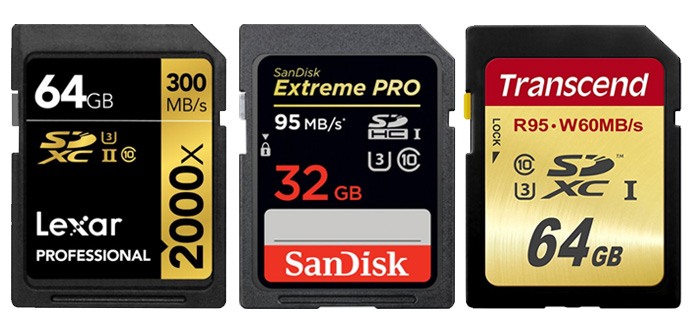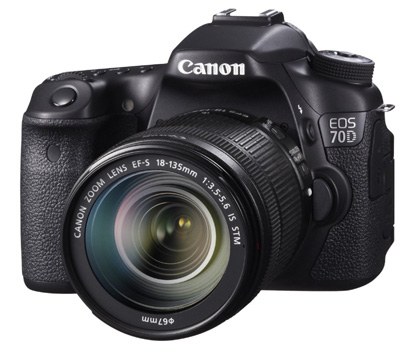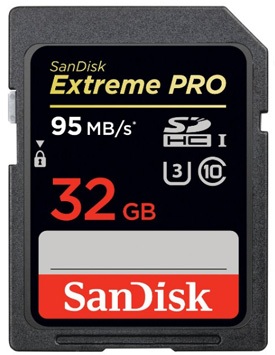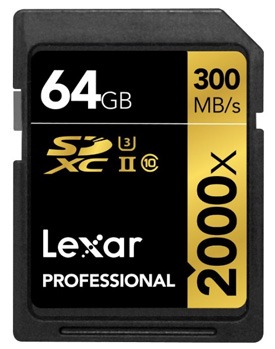The Canon EOS 70D can take advantage of UHS-I type memory cards which is why in this guide, we recommend UHS-I (both U1 and U3) only if you’re looking for the fastest writing speeds.
It can shoot at 7 frames per second in continuous mode, as well as Full HD at 30fps. Because prices of today’s cards are quite cheap, we recommend you to go with U3 class speed and never experience any lag!
Having a fast card also reduces the waiting time when the buffer fills, which is a common thing in action and wildlife photography.
If you do go with an UHS-II (can write at faster speeds, but that depends on the camera) memory card, you can still use it normally, but you won’t get any extra speed since the 70D, nor most newer DSLRs, don’t support it yet.

These are the best 3 SDHC/SDXC memory cards you can get:
- SanDisk Extreme Pro 95MB/s UHS-I U3
- Lexar Professional 300MB/s UHS-II U3
- Transcend R95/W60MB/s UHS-I U3
SanDisk Extreme Pro 95MB/s UHS-I U3
The SanDisk 64GB Extreme Pro 32GB U3 is our favorite card, seeing as it’s inexpensive and provides writing and reading speeds near 90MB/s. It’ll handle the 70D’s burst mode and Full HD video with ease.
The speed makes it perfect for whatever you’re doing; fast bursts with large megapixel cameras, 4K video, let alone Full HD. It comes in 16GB, 32GB, 64GB, 128GB and 256GB sizes.
You can buy it at Amazon or see more reviews here.
Lexar Professional 300MB/s UHS-II U3
The Lexar Professional 300MB/s UHS-II U3 offers faster speeds for both writing and reading files. The Canon 70D doesn’t support UHS-II so the only benefit you’ll get is from sending the files quicker to your computer.
Don’t have a memory card reader that supports such speeds? Luckily you get a free Lexar UHS-II reader along this card that will greatly reduce the waiting time. You also get a free downloadable Imaging Rescue software. It comes in 32GB, 64GB and 128GB sizes.
You can buy it at Amazon or see more reviews here.
Transcend R95/W60MB/s UHS-I U3
The most affordable on our list, yet still UHS-I, is the Transcend 64GB UHS-I U3. In terms of reading speed it goes up to 95MB/s, while for writing the maximum is 60MB/s.
Transcend, just like Lexar above, gives you the option of downloading their free image recovery program and they both work pretty good in most cases. It comes in 64GB, 128GB and 256GB sizes.
You can buy it at Amazon or see more reviews here.
Comparison of the 3 Memory Cards
| Card | Size | Speed |
| Sandisk Extreme Pro 95MB/s U3 | 32GB | Writing files: ~90MBs. Reading files: ~95MB/s |
| Lexar Professional 300MB/s U3 | 64GB | Writing files: ~240MB/s. Reading files: ~280MB/s |
| Transcend R95/W60MB/s U3 | 64GB | Writing files: ~60MB/s. Reading files: ~90MB/s |
What Brands are the Best?
Your photographs and videos are stored on a memory card, so you should definitely not try to save any money here by buying from unknown, cheap brands. While you save a few bucks, you probably won’t even get the advertised speeds, and are at a bigger risk of losing your shots.
We see too many beginners choosing the cheap route here, but until you transfer your shots to a computer/online, this is where they’re stored at. You want the memory card to be the most reliable piece of your equipment!
Stick to Sandisk, Lexar, Transcend, Kingston, Sony and Toshiba. There may be a few other good brands out there, but the ones we mentioned are already more than enough and offer great prices.
https://www.youtube.com/watch?v=HZSf2bKp9P0
Last Updated on September 14, 2021 by Nick Voorhees
First and foremost, I’m a husband and father. Then professionally I’m photographer, designer, blogger, and Esty store owner. My homebase is near the stunning Wasatch mountains in Utah but I love traveling with my family as part of our homeschooling journey. I also love teaching and helping out others. My faith is one of the biggest aspects of my life and brings be a consistent joy that I haven’t found in anything else. My main blog is BestPhotographyGear.com and I strive to make photography simple for anyone looking to learn or find gear for their individual needs. By nature, I like to study, research, and analyze things and I use that help provide the best advice and reviews I can.





2 Comments
oluyinka kolawole
September 9, 2017 at 7:33 amIt comes in 16GB, 32GB, 64GB, 128GB and 256GB sizes. ……will the larger sized cards work with this camera .. EOS 70D?
Nick
September 16, 2020 at 12:31 pmYes, you can use the memory cards that have more storage in this camera. The number of GB’s that a card has is just about the number of pictures or hours of video you’ll be able to record on the card before you run out of space. Although unless you need a really big card because you do really long photoshoots or trips I would generally recommend getting a couple smaller sized cards rather than one big one. So for example, two 64GB cards rather than one 128GB card. It’s nice to have a backup card incase something happens with one. Like the says goes “don’t put all your eggs in one basket.” Let us know if you have other questions we can help with.